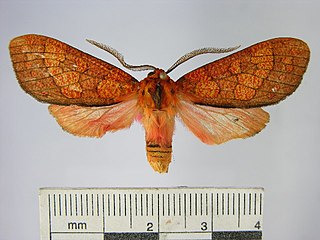
Agrius convolvuli, the convolvulus hawk-moth, is a large hawk-moth. It is common throughout Europe, Asia, Africa, Australia and New Zealand, partly as a migrant. In New Zealand, it is also known as the kumara moth, and in the Māori language as hīhue.

Goldeneye is the original name of novelist Ian Fleming's estate on Oracabessa Bay on the northern coastline of Jamaica. He bought 15 acres (6.1 ha) adjacent to the Golden Clouds estate in 1946 and built his home on the edge of a cliff overlooking a private beach. The three-bedroom structure was constructed from Fleming's sketch, fitted with wooden jalousie windows and a swimming pool. Fleming's visitors at Goldeneye included actors, musicians, and filmmakers, among others. As of 2010, the property operates as Goldeneye Hotel and Resort, consisting of Fleming's main house and several cottages, and it continues to host celebrities as resort guests.
Shaun Xavier Bridgmohan is a jockey in American Thoroughbred horse racing.

Jamaicans are the citizens of Jamaica and their descendants in the Jamaican diaspora. The vast majority of Jamaicans are of Sub-Saharan African descent, with minorities of Europeans, Indians, Chinese, Middle Eastern, and others of mixed ancestry. The bulk of the Jamaican diaspora resides in other Anglophone countries, namely Canada, the United States and the United Kingdom. Jamaican populations are also prominent in other Caribbean countries, territories and Commonwealth realms, where in the Cayman Islands, born Jamaicans, as well as Caymanians of Jamaican origin, make up 26.8% of the population. Outside of Anglophone countries, the largest Jamaican diaspora community lives in Central America, where Jamaicans make up a significant percentage of the population.
Cechenena catori is a moth of the family Sphingidae that occurs in Indonesia. They are nocturnal.

Elysius chimaera is a moth of the family Erebidae. It was described by Herbert Druce in 1893. It is found in southern Brazil and Paraguay.

Elysius conjunctus is a moth of the family Erebidae. It was described by Walter Rothschild in 1910. It is found in Brazil and Venezuela.

Elysius conspersus is a moth of the family Erebidae. It was described by Francis Walker in 1855. It is found in Panama, Colombia, Venezuela, Peru, Brazil, Paraguay and Ecuador.

Elysius gladysia is a moth of the family Erebidae. It was described by William Schaus in 1920. It is found in Guatemala.

Elysius melanoplaga is a moth of the family Erebidae first described by George Hampson in 1901. It is found in Ecuador and Bolivia.
Elysius jonesi is a moth of the family Erebidae. It was described by Walter Rothschild in 1910. It is found in Brazil.

Elysius sebrus is a moth of the family Erebidae. It was described by Herbert Druce in 1899. It is found in Brazil and Bolivia.
Elysius subterra is a moth of the family Erebidae. It was described by Walter Rothschild in 1917. It is found in Peru.
Elysius systron is a moth of the family Erebidae. It was described by William Schaus in 1904. It is found in Brazil.
The Barcode of Life Data System is a web platform specifically devoted to DNA barcoding. It is a cloud-based data storage and analysis platform developed at the Centre for Biodiversity Genomics in Canada. It consists of four main modules, a data portal, an educational portal, a registry of BINs, and a data collection and analysis workbench which provides an online platform for analyzing DNA sequences. Since its launch in 2005, BOLD has been extended to provide a range of functionality including data organization, validation, visualization and publication. The most recent version of the system, version 4, launched in 2017, brings a set of improvements supporting data collection and analysis but also includes novel functionality improving data dissemination, citation, and annotation. Before November 16, 2020, BOLD already contained barcode sequences for 318,105 formally described species covering animals, plants, fungi, protists.
Maxera marchalii is a moth of the family Erebidae.
Elachista talgarella is a moth of the family Elachistidae, which is commonly found in southern Kazakhstan.

Trosia nigropunctigera, commonly known as the rosy ermine moth, is a lepidopteran in the family Megalopygidae native to the Neotropics. These moths have a wingspan of 45-60mm, and are distributed across Costa Rica, Panama, Colombia, Venezuela, Guyana, Ecuador and Peru. The species was first described by David Stephen Fletcher in 1982.

Tortricidia pallida, the red-crossed button slug, is a moth of the family Limacodidae described by Gottlieb August Wilhelm Herrich-Schäffer in 1854. It is found in eastern North America from Nova Scotia west to Minnesota and south to Louisiana.
Xanthodirphia abbreviata is a species of moth in the family Saturniidae. It is found in Costa Rica.











